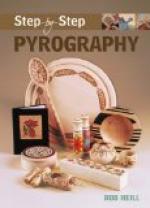The building of a cathedral seemed to be full of a kind of fairy lore. The plan was that of a crucifix, the chancel being the head, the transept the arms and the nave representing body and legs. The two western towers stood for Adam and Eve. There was a magic in numbers; three, seven and nine were better than six, eleven or thirteen. Certain flowers were marked for use in sacred sculpture as they were for other purposes. Euphrasy or eyebright with its little bright eye was a medicine for sore eyes. The four-petaled flowers,—the cross-bearers,—were never poisonous, and many of them, as mustard and cabbage, were valuable for food or medicine. But when Roger took this lore to Mother Izan for her opinion she remarked that if that was doctors’ learning it was no wonder they killed more folk than they cured.
In fact the three Lombard builders, while each man was a master of his own especial art, had done most of their work in cities, and when it came to matters of the fields and woods they were not to be trusted. But when David found Roger a little inclined to vaunt his superior woodcraft he set him a riddle to answer:
“The baldmouse
and the chauve-souri,
The
baukie-bird and bat,
The barbastel
and flittermouse,—
How
many birds be that?”
And the masons were all grinning at him before Roger found out that these were half a dozen names for the bat, from as many different places.
The vaulting of the roof of the church was now under consideration. For so small a building the “barrel vault,” a row of round arches, was often used; but David’s voice was for the pointed arch throughout. “The soarin’ curve lifts the eye,” he said, “like the mountains yonder.” He drew with a bit of charcoal a line so beautiful that it was like music. It was not merely the meeting of two arcs of a circle, but the meeting of two mysteriously curved perfect lines. Sir Walter Giffard saw at a glance that here was the arch he had dreamed of.
He saw more than that. David was that rare builder, a man who can work with his hands and see all the time inside his soul the completed work. He could no more endure slipshod work or graceless lines in his building than the knight himself could do a cowardly or dishonest thing. David would have done his task faithfully in any case, but it rejoiced his soul to find that the knight and his lady would know not only that their village church was beautiful, but why it was so.
Andrew was at work upon the decorative carving of the arches of the doorway. The outer was done in broad severe lines heavily undercut; the next inner arch in a simple pattern of alternating bosses and short lines--Andrew called it the egg and dart pattern—and the inner arch in a delicate vine rather like the ivy that grew over the keep. Andrew said it was a vine found in the ruins of the Coliseum at Rome.
When it came to the carving of the animals and birds and figures for the inside of the church, Andrew’s designs did not quite suit Lady Philippa. They were either too classical or too grotesque; they were better fitted to the elaborate richness of a great cathedral than to a little stone church in the mountains. She would have liked figures which would seem familiar to the people, of the birds and beasts they knew, but Andrew did not know anything about this countryside.




